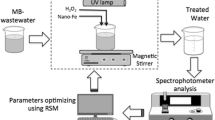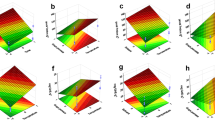Abstract
Photo-Fenton reaction is being used in different industrial processes due to their efficient degradation of toxic organic pollutants. In this study, the effect of induced photo-Fenton reaction (H2O2/Fe2+/vis) in a white wine was investigated in the presence of visible light irradiation from light-emitting diodes, at constant temperature in all the experiments. The statistical design was based on three independent factors (H2O2/Fe2+/light) and five responses titratable acidity (TA), pH, total polyphenol index (TPI), total colour differences (ΔE ab*) and ochratoxin A (OTA) using response surface methodology by Box–Behnken design. The total sulphur dioxide, browning index (BI) and major volatiles of the wine changes were also studied. The concentration of OTA was evaluated using enzyme-linked immunosorbent assay method. At the tested conditions, minor variations on some oenological parameters (TA and pH) were observed after photo-Fenton-controlled reaction, but other deleterious effects were observed (ΔE ab*, TPI and BI). The optimum 61.5 % OTA removal was achieved for irradiation dosage of 1410 lx, H2O2 and Fe2+ dosages over 2.08 and 0.085 mM L−1, respectively. This study shows that reduction of OTA may be possible using an induced photo-Fenton reaction in an artificially contaminated white wine.







Similar content being viewed by others
References
Danilewicz JC (2003) Review of reaction mechanisms of oxygen and proposed intermediate reduction products in wine: central role of iron and copper. Am J Enol Vitic 54:73–85
Waterhouse A, Lauri VF (2006) Oxidation of wine phenolics: a critical evaluation and hypotheses. Am J Enol Vitic 57:306–313
Karbowiak T, Gougeon RD, Alinc J-B, Brachais L, Debeaufort F, Voilley A, Chassagne D (2010) Wine oxidation and the role of cork. Crit Rev Food Sci Nutr 50:20–52
Elias RJ, Waterhouse AL (2010) Controlling the Fenton reaction in wine. J Agric Food Chem 58:1699–1707
Li H, Guo A, Wang H (2008) Mechanisms of oxidative browning of wine. Food Chem 108:1–13
Panizza M, Cerisola G (2011) Removal of organic pollutants from industrial wastewater by electrogenerated Fenton’s reagent. Water Res 35:3987–3992
Deng Y (2007) Physical and oxidative removal of organics during Fenton treatment of mature municipal landfill leachate. J Hazard Mater 146:334–340
Méndez-Arriaga F, Esplugas S, Giménez J (2010) Degradation of the emerging contaminant ibuprofen in water by photo-Fenton. Water Res 44:589–595
Bidga RJ (1995) Consider Fenton chemistry for wastewater treatment. Chem Eng Prog 91:62–66
Machulek A, Quina FH, Gozzi F, Silva VO, Friedrich LC, Moraes EF (2012) Fundamental mechanistic studies of the photo-Fenton reaction for the degradation of organic pollutants. In: Puzyn T (ed) Organic pollutants ten years after the Stockholm convention: environmental and analytical update. Intech Europe Rijeka, Croatia
Ghiselli G, Jardim WF, Litter MI, Mansilla HD (2004) Destruction of EDTA using Fenton and photo-Fenton-like reactions under UV-A irradiation. J Photochem Photobiol A 167:59–67
Battilani P, Magan N, Logrieco A (2006) European research on ochratoxin A in grapes and wine. Int J Food Microbiol 111:S2–S4
Mantle PG (2002) Risk assessment and the importance of ochratoxins. Int Biodeter Biodegr 50:143–146
Bennett JW, Klich M (2003) Mycotoxins. Clin Microbiol Rev 16:497–516
Commission Regulation EC 1881/06 of 19 December 2006, setting maximum levels for certain contaminants in foodstuffs. Off J Eur Comm L364:5–24
Varga J, Kocsubé S, Péteri Z, Vágvölgyi C, Tóth B (2010) Chemical, physical and biological approaches to prevent ochratoxin induced toxicoses in humans and animals. Toxins 2:1718–1750
Kabak B, Dobson ADW, Var I (2006) Strategies to prevent mycotoxin contamination of food and animal feed: A review. Crit Rev Food Sci Nutr 46:593–619
Espejo F, Armada S (2009) Effect of activated carbon on ochratoxin A reduction in “Pedro Ximenez” sweet wine made from off-vine dried grapes. Eur Food Res Technol 299:255–262
Bornet A, Teissedre PL (2008) Chitosan, chitin-glucan and chitin effects on minerals (iron, lead, cadmium) and organic (ochratoxin A) contaminants in wines. Eur Food Res Technol 226:681–689
Appell M, Jackson MA (2012) Sorption of ochratoxin A from aqueous solutions using β-cyclodextrin-polyurethane polymer. Toxins 4:98–109
Tomašević-Čanović M, Daković A, Rottinghaus G, Matijašević S, Ðuričić M (2003) Surfactant modified zeolites–new efficient adsorbents for mycotoxins. Micropor Mesopor Mat 61:173–180
Varga J, Péteri Z, Tábori K, Téren J, Vágvölgyi C (2005) Degradation of ochratoxin A and other mycotoxins by Rhizopus isolates. Int J Food Microbiol 99:321–328
Bejaoui H, Mathieu F, Taillandier P, Lebrihi A (2006) Biodegradation of ochratoxin A by Aspergillus section Nigri species isolated from French grapes: a potential means of ochratoxin A decontamination in grape juices and musts. FEMS Microbiol Lett 255:203–208
Abrunhosa L, Venâncio A (2007) Isolation and purification of an enzyme hydrolyzing ochratoxin A from Aspergillus niger. Biotechnol Lett 29:1909–1914
Var I, Erginkaya Z, Kabak B (2009) Reduction of ochratoxin A levels in white wine by yeast treatments. J Inst Brew 115:30–34
Fuchs S, Sontag G, Stidl R, Ehrlich V, Kundi M, Knasmüller S (2008) Detoxification of patulin and ochratoxin A, two abundant mycotoxins, by lactic acid bacteria. Food Chem Toxicol 46:1398–1407
Visconti A, Perrone G, Cozzi G, Solfrizzo M (2008) Managing ochratoxin A risk in the grape-wine food chain. Food Addit Contam A 25:193–202
Patel UD, Govindarajan P, Dave PJ (1989) Inactivation of aflatoxin B1 by using the synergistic effect of hydrogen peroxide and gamma radiation. Appl Environm Microbiol 55:465–467
Kostechi M, Golinski P, Uchman W, Grabarkiewicz-Szczesna J (1991) Decomposition of ochratoxin A by heat and gamma-irradiation. IARC Sci Publ 115:109–111
Di Stefano V, Pitonzo R, Avellone G (2014) Effect of gamma irradiation on aflatoxins and ochratoxin A reduction in almond samples. J Food Res 3:113–118
Boudra H, Le Bars P, Le Bars J (1995) Thermostability of ochratoxin A in wheat under two moisture conditions. Appl Environ Microb 61:1156–1158
Bullerman LB, Bianchini A (2007) Stability of mycotoxins during food processing. Int J Food Microbiol 119:140–146
Kabak B (2009) The fate of mycotoxins during thermal food processing. J Sci Food Agric 89:549–554
Cigić I, Strlič M, Schreiber A, Kocjančič M, Pihlar B (2006) Ochratoxin A in wine: its determination and photostability. Anal Lett 39:1475–1488
Gillman IG, Yezek JM, Manderville RA (1998) Ochratoxin A acts as a photoactivatable DNA cleaving agent. Chem Commun 6:647–648
Schmidt-Heydt M, Bode H, Raupp F, Geisen R (2010) Influence of light on ochratoxin biosynthesis by Penicillium. Mycotox Res 26:1–18
Schmidt-Heydt M, Cramer B, Graf I, Lerch S, Humpf H-U, Geisen R (2012) Wavelength-dependent degradation of ochratoxin and citrinin by light in vitro and in vivo and its implications on Penicilium. Toxins 4:1535–1551
Moreau M, Lescure G, Agoulon A, Svinareff P, Orange N, Feuilloley M (2013) Application of the pulsed light technology to mycotoxin degradation and inactivation. J Appl Toxicol 33:357–363
Ribéreau-Gayon P, Glories Y, Maujean A, Dubourdieu D (2000) Handbook of enology. The chemistry of wine stabilization and treatments, vol 2. Wiley, New York
Fouler SG, Trivedi AB, Kitabatake N (1994) Detoxification of citrinin and ochratoxin A by hydrogen peroxide. J AOAC Int 77:631–637
Altuğ T, Yousef AE, Marth EH (1990) Degradation of Aflatoxin B1 in dried figs by sodium bisulfite with or without heat, ultraviolet energy or hydrogen peroxide. J Food Prot 53:581–582
Jalili M, Jinap S (2012) Reduction of mycotoxins in white pepper. Food Addit Contam A 29:1947–1958
Guedes AMF, Madeira LMP, Boaventura RAR, Costa CAV (2003) Fenton oxidation of cork cooking wastewater-overall kinetic analysis. Water Res 37:3061–3069
Bezerra MA, Santelli RE, Oliveira EP, Villar LS, Escaleira LA (2008) Response surface methodology (RSM) as a tool for optimization in analytical chemistry. Talanta 76:965–977
Tripathi S, Mishra HN (2011) Modeling and optimization of enzymatic degradation of Aflatoxin B1 (AFB1) in red chili powder using response surface methodology. Food Bioprocess Technol 4:770–780
Laurie VF, Waterhouse AL (2006) Oxidation of glycerol in the presence of hydrogen peroxide and iron in model solutions and wine. Potential effects on wine color. J Agric Food Chem 54:4668–4673
Gislason NE, Currie BL, Waterhouse AL (2011) Novel antioxidant reactions of cinnamates in wine. J Agric Food Chem 59:6221–6226
International Organisation of Vine and Wine (OIV) (2011) Compendium of international methods of wine and must analysis, vol 1. France, Paris
Commission Regulation EC 2870/00 of 19 December 2000, lying down Community reference for the analysis of spirit drinks. Off J Eur Comm L333:20–46
Sioumis N, Kallithraka S, Makris DP, Kefalas P (2006) Kinetics of browning onset in white wines: influence of principal redox-active polyphenols and impact on the reducing capacity. Food Chem 94:98–104
Dong Y, Han S, Dong S, Wu J, Ding Z (2011) Enhanced catalytic activity of Fe bimetallic modified PAN fiber complexes prepared with different assisted metal ions for degradation of organic dye. Catal Today 175:299–309
Bejarano MJR, Dodero MCR, Barroso CG (2010) Optimizing the process of making sweet wines to minimize the content of ochratoxin A. J Agric Food Chem 58:13006–13012
Arslan-Alaton L, Tureli G, Olmez-Hanci T (2009) Treatment of azo dye production wastewaters using photo-Fenton-like advanced oxidation processes: optimization by response surface methodology. J Photochem Photobiol A 202:142–153
De Heredia JB, Torregrosa J, Dominguez JR, Peres JA (2001) Kinetic model for phenolic compound oxidation by Fenton’s reagent. Chemosphere 45:85–90
Carlsen C, Stapelfeldt H (1997) Light sensitivity of elderberry extract. Quantum yields for photodegradation in aqueous solution. Food Chem 60:383–387
Pignatello JJ, Oliveros E, MacKay A (2006) Advanced oxidation processes for organic contaminant destruction based on the Fenton reaction and related chemistry. Crit Rev Env Sci Tec 36:1–84
Sekaran G, Karthikeyan S, Evvie C, Boopathy R, Maharaja P (2013) Oxidation of refractory organics by heterogeneous Fenton to reduce organic load in tannery wastewater. Clean Techn Environ Policy 15:245–253
Sadilova E, Carle R, Stintzing FC (2007) Thermal degradation of anthocyanins and its impact on color and in vitro antioxidant capacity. Mol Nutr Food Res 51:1461–1471
Kallithraka S, Salacha MI, Tzourou I (2009) Changes in phenolic composition and antioxidant activity of white wine during bottle storage: accelerated browning test versus bottle storage. Food Chem 113:500–505
Maury C, Clark AC, Scollary GR (2010) Determination of the impact of bottle colour and phenolic concentration on pigment development in white wine stored under external conditions. Anal Chim Acta 660:81–85
Simpson RF (1982) Factors affecting oxidative browning of white wine. Vitis 21:233–239
Oliveira CM, Ferreira AC, De Freitas V, Silva AMS (2011) Oxidation mechanisms occurring in wines. Food Res Int 44:1115–1126
Author information
Authors and Affiliations
Corresponding author
Ethics declarations
Conflict of interest
None.
Compliance with Ethics Requirements
This article does not contain any studies with human or animal subjects.
Rights and permissions
About this article
Cite this article
Espejo, F. Effect of photo-Fenton reaction on physicochemical parameters in white wine and its influence on ochratoxin A contents using response surface methodology. Eur Food Res Technol 242, 91–106 (2016). https://doi.org/10.1007/s00217-015-2521-z
Received:
Revised:
Accepted:
Published:
Issue Date:
DOI: https://doi.org/10.1007/s00217-015-2521-z




